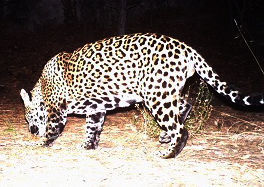A male jaguar — likely the sixth documented in the Southwest since 1996 — was photographed last week on Fort Huachuca, authorities said Wednesday.
The jaguar is believed to be separate from the male jaguar known as “El Jefe,” who was photographed from 2012 to 2015 in the Santa Rita Mountains, authorities said. It was the first confirmed jaguar sighting ever at Fort Huachuca, said Angie Camara, a Fort Huachuca spokeswoman.
This jaguar, photographed in the evening on Dec. 1, appeared to weigh about 150 to 200 pounds, compared to more than 200 pounds for more mature adults, said Mark Hart, an Arizona Game and Fish Department spokesman. The jaguar that roamed the Santa Ritas weighed about 210 pounds, he said.
The discovery adds fuel to the longstanding dispute between environmentalists and state game officials over whether Arizona has a viable jaguar population worth protecting, or whether the jaguars seen represent only a fringe population with little or no biological significance.
The latest sighting shows “that these cats will continue returning to the United States and will survive here as long as we protect the habitat they need,” said Randy Serraglio, a conservation advocate for the Center for Biological Diversity.
This jaguar’s presence in Arizona shows that males are starting to re-establish themselves here, since only one confirmed jaguar sighting occurred from 1976 to 1996, said Rob Peters, Defenders of Wildlife’s senior Southwest representative.
“I’m convinced after looking at data and talking to different jaguar experts that there was originally a population that straddled the border and clearly included reproduction in the U.S.,” Peters said.
But Game and Fish spokesman Hart said, “We continue to hold that we are on the northern periphery of their range, and that the primary reason is that there have been no credible sightings of females here since the 1940s.”
Jim deVos, an assistant Game and Fish director, has said that the number of jaguars documented here in the past century is too small for Arizona to be an important factor in regional jaguar conservation. Jaguars are much more common in Mexico, although the species is also listed as endangered there.
“The jaguars are a unique component of Arizona’s wildlife, but when you look at the species as a whole, I’m hard-pressed to say we play a significant role given the lack of animals in the past 50 years or 100 years,” deVos told the Star last spring.
The new photo was taken by a trail camera managed by fort officials. Both they and Game and Fish declined to be specific about where on the 73,000-acre Army fort the photo was taken. Fort spokeswoman Camara would say only that it was found “in the heart of the Huachuca Mountains,” amidst the steep, rocky, heavily forested terrain that is characteristic of that Southern Arizona range near Sierra Vista.
The photo apparently was first made public Tuesday afternoon by the Cochise County District of the Boy Scouts of America, on its Facebook page.
Cochise Boy Scout officials didn’t respond to questions about how they got the photo. One referred a reporter to Fort Huachuca’s Facebook page for details on the jaguar. Camara said she doesn’t know how the scouts got it. Game and Fish and the U.S. Fish and Wildlife Service, which manages endangered species, then put out a news release on the jaguar mid-morning Wednesday.
Hart said the game department got its first look at a jaguar photo from the Huachucas on Monday. It issued the news release shortly after the Star contacted the agency about the photo Wednesday morning. Hart said the agency had been working on an announcement since the previous day.
Environmentalists, fort officials and game and wildlife officials were all thrilled by the discovery. The last confirmed jaguar sighting in Arizona occurred in September 2015, when the final round of photos and video footage of “El Jefe” was taken by remote cameras in the Santa Ritas. That jaguar was first photographed in November 2011 in Southern Arizona’s Whetstone Mountains before moving to the Santa Ritas, southeast of Tucson.
“It’s exciting, but right now our first priority is making sure the jaguar is safe and our folks here are safe as well,” Camara said. “We want to make sure we are not doing anything that would put the animal or our personnel at risk.”
Hart said Game and Fish wants to ensure the welfare of the jaguar and the general public. The agency doesn’t want people to go up into the mountains to look for the jaguar and wants to avoid illegal “take” of an endangered species. Under federal law, take means killing, harming or harassment of an endangered animal, and Hart said pursuing or stalking the animal would also be illegal.
“We don’t want people going up there other than those who routinely use that area,” he said. “We don’t want to disturb the natural movement of the jaguar. It’s a dangerous cat, larger than a mountain lion.”
The jaguar photo on the Boy Scouts’ Facebook page drew more than 100 comments, most expressing happiness and concern for the animal’s welfare. It was shared by 2,200 people.
Jennifer Setzler, whose Facebook page didn’t say where she lives, posted, “Beautiful. Please don’t go looking for it and get it shot.”
Chris Evans of Toronto posted, “Hopefully there is a breeding pair, repopulating the Southwest.”
Ruth Cullen Hall of Bozeman, Montana, posted, “Let it be. Too many people would like to shoot one.”
But Jennifer Jones, a Sierra Vista resident, was less thrilled about the discovery, making an apparent reference to Endangered Species Act restrictions when she posted, “Just so you all know, if another one shows up that’s the end of Ft. Huachuca and everyone’s job.”





